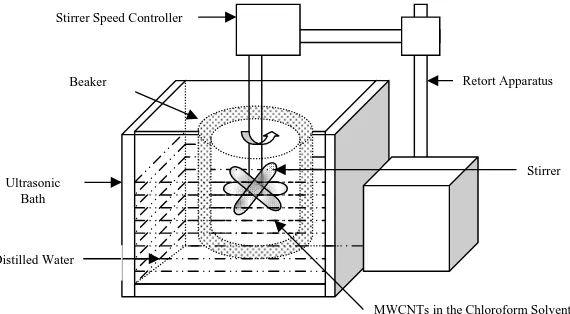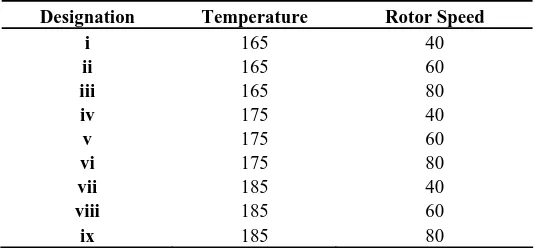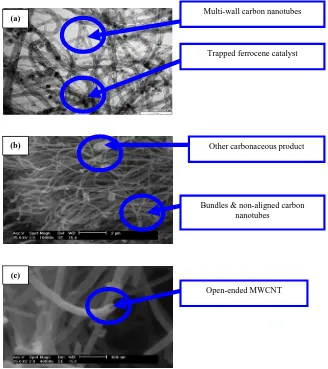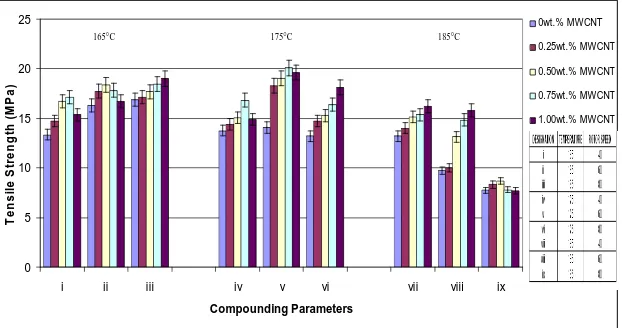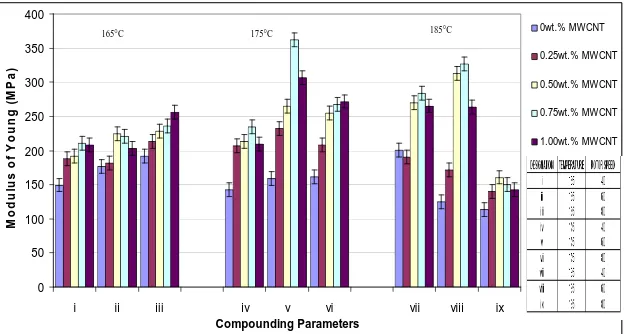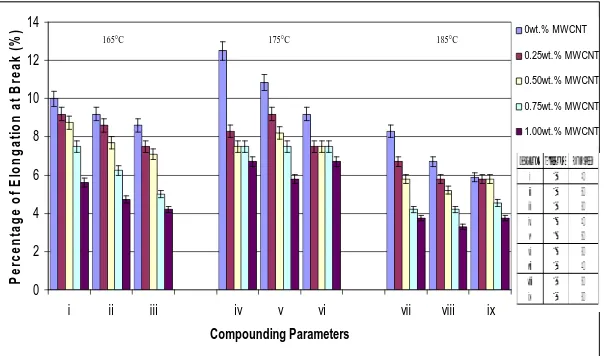© School of Engineering, Taylor’s University College
THE INFLUENCES OF MELT-COMPOUNDING PARAMETERS
ON THE TENSILE PROPERTIES OF LOW FILLER LOADING OF
UNTREATED-MWCNTs-POLYPROPYLENE (PP)
NANOCOMPOSITES
M.A.MOHD SALLEH 1, J. ABD. RAZAK 2*, N.A. IBRAHIM 3, A. FAKHRU’L RAZI1, A.R. SURAYA1
1Chemical Engineering Department, Faculty of Engineering 2Chemistry Department, Faculty of Science
Universiti Putra Malaysia, 43400 UPM, Serdang, Selangor Darul Ehsan, MALAYSIA. 3Materials Engineering Department, Manufacturing Engineering Faculty, Universiti Teknikal Malaysia Melaka, Industrial Campus, 75450, Ayer Keroh, Melaka, MALAYSIA.
*Corresponding Author: [email protected]
Abstract
1.
Introduction
Polymer/CNTs composites have attracted considerable attention owing to their unique mechanical, surface and multi functional properties and strong interactions with the matrix, which resulting from the nano-scale microstructure and extremely large interfacial area [1]. Incorporation of CNTs into a polymer matrix can potentially provide structural materials with dramatically increased modulus and strength [2]. However, the reinforcing potential of CNTs is still widely undeveloped and needs further basic research. Assouline et al. cited from [1], found that the addition of 1 wt. % of MWCNTs into PP matrix increased the composites toughness due to the fibrillar crystal structure of PP induced by MWCNT [1]. Manchado et al. [3] found that CNT could be dispersed uniformly in PP by shear mixing, at minimum low filler loading, and they found that by adding 0.25–0.75 wt. % CNT into PP increased its tensile strength and stiffness as well as storage modulus considerably [3]. From this finding it can be claimed that, low amount addition of MWCNT into polymer matrix was still capable to improve its mechanical properties. Thus it will be tested in this study, by using the self synthesised MWCNTs which produced at the limited laboratory scale quantity. Polymer processing methods use large-scale quantities of raw materials, which are sometimes inappropriate when developing new composites based on costly filler such as CNT. Thus commercial MWCNT is not used due to the cost factor and this study was opt to use the low filler amount of loading (0 – 1 wt. %) of MWCNTs, since the study conducted by Breuer and Sundararaj [4] found that the low CNT loading of a few percentage was also significant in preserving the original physical properties of the polymer matrix [4].
To-date, the main challenges in CNT based polymer nanocomposites are to improve the uniform dispersion and alignment of CNTs within the polymer matrix, during the processing of these nanocomposites [1, 5]. CNTs are easy to agglomerate, bundle together and entangle, leading to many defect sites in the composites, and limiting the efficiency of CNTs on polymer matrices [1]. As an effort to solve these problems, this study has been emphasised the method of pre-compounding, in a way to pre-disperse the filler used. MWCNTs were first sonicated and mechanically stirred simultaneously in the chloroform solvent, prior to their incorporation with polypropylene matrix. Hence, the efficiency of the internal mixer machine in dispersing different weight percentage of untreated MWCNT within the polymer matrix will also be studied, where the melt-blending compounding parameters of temperature and rotation of roller rotor shearing blade were varied.
ability to disperse the CNT’s individually and uniformly throughout the matrix without destroying their integrity or reducing their aspect ratio [4].
2. Materials and Methods
2.1 Raw materials
Polypropylene is used as matrix in this research is a product from TITAN PETCHEM (M) Sdn. Bhd., with commercial name of TITANPRO SM950. This type of polypropylene is classified as impact copolymer and has MFI value of 60g/10min at 230°C. The chemical used in this study was benzene (C6H6) with
99.5% purity. Benzene was used as a hydrocarbon source during synthesis of CNTs through FC-CVD process. Benzene has atomic mass of 78.11 g/mol. Ferrocene (FeC10H10) with 98% purity was used as a source of the ultra fine iron
catalysts particles which reacted with benzene during chemical vapour deposition synthesis process. Ferrocene has a molecular weight of 186.04 with the brand name of ACROS ORGANICS. Two types of gases (supplied by MOX, Malaysia) were used; pure hydrogen (H2) with 99.99% of purity and pure argon (Ar) with
99% of purity.
2.2 Preparation of MWCNTs by FC-CVD method
The chemical vapour deposition (CVD) method was employed for the synthesis of CNT. Girun et al. [7] described that this method is cheap and requires a relatively low deposition temperature compared to other techniques used to synthesise CNT. The parameter used to synthesis the MWCNT was 50 minutes reaction period, 850°C reaction temperatures, 350 ml/min hydrogen flow rate and 200 mg amount of ferrocene catalyst used. Argon gas was injected into the CVD reactor to prevent the oxidation of catalytic metal while raising the setting temperature. In order to produce the ferrocene vapour, the boat containing ferrocene which located at the edge of the ceramic tube, inside the CVD reactor was heated up to the temperature of 120°C, right after the reaction temperature had reached. After all the setting temperature became stable, hydrogen gases were bubbled into the benzene Erlenmeyer flask to form a mixed vapour of hydrogen and benzene for 50 minutes reaction period. Later, the furnace temperature was cooled down and then carbon nanotubes were collected from the ceramic boat and the wall of the ceramic tube.
2.3
Ultrasonication and mechanical stirring for MWCNTs filler
powder was crushed by using an agate mortar. At this stage, it was assumed that, MWCNT is in the separate form between each other.
Fig.1. Ultrasonication-Mechanical Stirrer Apparatus Set-Up for MWCNTs Dispersion Procedure.
2.4 Characterisation of MWCNTs morphology by SEM & TEM
Morphology observation through SEM for the MWCNT, was performed on a Philips XL30 (Holland) Environmental Scanning Electron Microscope (ESEM). Samples of MWCNT were first adhered onto the surface of carbon tape and then mounted on the aluminium stubs which were then sputter-coated with a thin layer of gold by using sputter coater Polaron E-1500, in order to avoid the electrostatic charging phenomena during the observation. ESEM was operated at 25.0 KV accelerating voltage and signal was detected by secondary electron detector. Morphology observations through TEM for the MWCNT were performed on a Philips TEM-400 Transmission Electron Microscopy (TEM). Sample of MWCNT were first sonicated in alcohol solvent within 10 minutes, in order to disperse it. One drop of mixture was dropped properly onto the surface of holey formvar grid for negative staining and sample was dried prior their imaging.
2.5 Melt blending via internal mixer
Self synthesised MWCNT was pre-dried prior to weighing which carried out at 80°C for 24 hours in controlled vacuum oven. It was done purposely to expel any moisture from trapping within untreated MWCNT filler. All formulations were weighted based on the weight percentage from the total 40 gram per compounding. MWCNT-PP nanocomposites were prepared by melt blending in an internal mixer using the Thermo Haake PolyDrive - Rheomix R600/610 with various compounding parameters which summarised as in the following Table 1.
Retort Apparatus
Stirrer Stirrer Speed Controller
Beaker
MWCNTs in the Chloroform Solvent Ultrasonic
Bath
Table 1. Description of the Composites Compounding Parameters Designation Used.
Designation Temperature Rotor Speed
i 165 40
ii 165 60
iii 165 80
iv 175 40
v 175 60
vi 175 80
vii 185 40
viii 185 60
ix 185 80
In the preparation procedure, the thermoplastic PP were first loaded into the internal mixer and preheated for two minutes without rotation of roller rotor blade. Next eight minutes of compounding period were allocated and required amount of MWCNT (0, 0.25, 0.50, 0.75 & 1.00 wt %) were added to melted PP after four minute. The compounded recipes were then compression moulded using HSINCHU hot press size of 15x15 cm with the thickness of 1 mm for 10 minutes preheat and another 10 minutes compression period under a pressure of 150 kg/cm2 at 185°C. The sheets obtained were immediately cooled between two plates of a water flow assisted cold pressed at room temperature for 10 minutes of cooling cycle.
2.6 Mechanical tensile testing
One millimetre thick dumb bell specimens were cut from the moulded sheets with a die cutter. Seven samples were tested for each composite formulation. Tensile tests were carried out according to ASTM D-638 on an Instron Universal Testing Machine 4302 with a load capacity of 1kN at cross head speed of 5 mm/min. The test was performed at 25±3°C in the humidity of 50%.
3. Results and Discussion
3.1 Morphological observation of synthesised MWCNTs
collected CNTs were combined from all zones of ceramic tube and ceramic boat. Carbon nanotubes produced were not really straight in their structure and moderately long in their length. It is found that, MWCNTs produced were not really clean, wherein there is too many catalyst particle trapped inside the hollow tube, walls and at the edge of the tube. Observation through SEM with magnification of 10 000 X (Fig. 2(b)) shows that the carbon nanotubes produced were in the bundles, long structure and not well aligned. Presence of another carbonaceous product like amorphous carbon was detected through this observation. By increasing the magnification of SEM to 40 000 X (Fig. 2(c)), it can be clearly seen that the MWCNTs produced were open-ended type.
Fig.2. Morphology Observation of Synthesised MWCNTs through TEM & SEM.
Multi-wall carbon nanotubes
Trapped ferrocene catalyst
Other carbonaceous product
Bundles & non-aligned carbon nanotubes
Open-ended MWCNT
(a)
(b)
3.2 Tensile properties evaluation
3.2.1 Tensile strength curves
Based on the bar-chart plotted (Fig. 3), there are three separations of categories in the graph. Effect of three compounding temperature in correlation with different rotation speed of roller rotor shearing blade at different compounding recipes (varied weight percentage of MWCNT) were studied. Group (i-iii) represent 165°C of compounding temperature, whereas group (iv-vi) and (vii-ix), represent compounding temperature of 175 and 185°C, respectively. From the first phase of the plotted bar-chart, it was shown that the overall tensile strength properties were monotonically increased with the increasing rotation speed of roller rotor blade over the amount of filler loading. Provided that, group i and ii shows the increment in the tensile strength properties up to the certain amount of filler loading, which are 0.75 and 0.50wt. % respectively, prior to their decrement in their subsequent amount of filler loading. Based from Gojny et al. [8], it is believed that the slight reduction in the tensile strength value at higher nanofiller contents can be attributed to an increasing amount of improper impregnated agglomerates, acting as imperfections in the composite, inducing early failure [8].
0
Fig.3. Tensile Strength of PP-MWCNTs Composites Compounded at 165-185°C at Various Roller Rotor Speed of Internal Mixer.
of nanotubes agglomeration which commonly occurred when it exist in large quantity in the compounding recipes.
Overall the pattern of the plot for the group (iv-vi) showed very good improvement in their tensile strength properties in comparisons with the un-filled matrix of PP polymer, where the most significant enhancement of tensile strength was obtained from the group of composites fabricated from CNTs which compounded at 175°C and 60 rpm which report an increment. The present results for the composites from group (vi) shows an almost linear increase of the measured tensile strength value in relation to the filler content, yielding at the maximum of 18.15 MPa at 1.00 wt. % MWCNT addition, under the given processing condition. This finding is in accordance with the previous work conducted by Park et al. [9], where in their study they found that, as CNT content increased, the tensile strength is increased gradually by the general rule of mixture. They claimed that polymer matrix added with CNT can increase the tensile properties and fracture energy because the crack propagation can be blunted by bridging up the crack faces [9]. Kueseng et al. [10] found that by incorporation of CNT even at low as 1.5% filler content, the tensile strength of nanocomposites was enhanced [10].
Application of compounding parameters for the group (viii) and (ix) was diminished its tensile strength properties of pure PP matrix, where the values plotted are lower than 10 MPa. Thus, it can be claimed that the temperature of 185°C with rotor speed of 60 and 80 rpm respectively is not suitable for MWCNT-PP composites fabrication. High temperature of compounding may expose the molecular chain of PP with the processing degradation, which generally will decrease its mechanical properties. With the exposure of high shearing rotation of roller rotor blade (80 rpm at 185°C), the effect of high temperature to the tensile properties of the fabricated composites becomes worst. This phenomenon can be seen at the group (ix), where all the plotted values are among the lowest, where the pattern of plot for this group of composites seems is level with no great improvement in its properties.
Thus, it can be concluded that temperature of compounding and roller rotor speed of melt blending, plays an important roles in the tensile strength properties of composites which containing lower amount of MWCNT filler loading. Both parameters are mutually correlates between each other and it should be highlighted as a main consideration during the development and production of carbon nanotubes based polymer nanocomposites in the real bulk manufacturing.
3.2.2 Modulus of Young curves
for groups (i-iii), monotonically increased for groups (iv-vi) and drastically decreased for the groups (vii-ix). Generally, for each group of compounding, addition of low amount of MWCNT was increased their value of modulus in comparison with the control sample, but only up to the certain level of amount before its properties dropped.
However, this is different with the group (vii), where the tested value of modulus was dropped when the 0.25wt. % MWCNT is added and increased again until the addition of 0.75wt. % MWCNT, before it dropped again at the addition of 1.00wt. % MWCNTs. It may due to the failure of compounding parameters (lower speed of roller rotor; 40 rpm); to fully disperse the MWCNT added which may create the formation of MWCNT agglomerates that tend to be the origin of flaw which may create failure, during the testing. The increment of modulus of young properties was not significantly occurred at the group (i-iii), where the temperature used is 165°C. The effect of roller rotor speed in this phase was not too obvious where the plot of the graph seems to be level. Great improvement of this property was occurred for all group of compounding in the second phase of the bar chart plotted (groups iv-vi) and only at the group (vii) and (viii) for the third phase of the graph. Highest increment of this property was occurred at the group (viii), where addition of only 0.75wt. % MWCNT, contributed to the enhancement of Modulus of Young value up to the 162.3%.
0
Fig.4. Modulus of Young of PP-MWCNTs Composites Compounded at 165-185°C at Various Roller Rotor Speed of Internal Mixer.
0.75 wt. % MWCNT was applied, where it improved the modulus of young value up to 128% in comparison with the pure PP which compounded at the same parameter of compounding.
Generally, using temperature of 185°C with high roller rotor speed of 80 rpm gives the value of modulus among the lowest compared to others. Again, it is revealed that this compounding parameter (group (ix)), is totally not suitable for the MWCNTs-PP nanocomposites fabrication. However, using this temperature but lowering the speed of shearing blade, still capable to give promising result of improvement in its properties for Modulus of Young.
3.2.3 Percentages of elongation at break curves
In overall, by increasing the temperature of compounding for each group, the percentages of elongation at break were decreased over the increasing amount of MWCNT filler loading. It can be seen that the pattern of plots for the first three groups in the first phase of the bar chart was proportionally decreased with the increasing roller rotor speed and the amount of filler addition. The decrement of elongation at break value in comparison with the value plotted for pure PP in each group from the first set (using 165°C), was not so difference.
Generally addition of lower filler amount caused the fabricated composites improved in their strength but diminished its capability to retain its ductility properties. The decreasing pattern of plot (Fig. 5) shows that the fabricated composites become brittle with the addition of MWCNT, even at the lower amount of addition. This finding is in agreement with the result obtained by Girun et al. (2007). They reported that the decrease in elongation at break with the increasing amount of CNTs that is rigid arises from the fact that the actual elongation experience by the polymer matrix is much greater than the measured elongation of the nanocomposites specimen [7]. Although the specimen is part of filler that is CNTs and part of matrix that is polymer PP, all the elongation is comes from the polymer if the filler is rigid. As the amount of CNTs is increased, the amount of polymer should be decreased. Thus, the decrement of elongation at break indicates that the incorporation of CNTs into polymer can improve the stiffness of the fabricated composites [7].
0
Fig.5. Percentages of Elongation at Break of PP-MWCNTs Composites Compounded at 165-185°C at Various Roller Rotor Speed of Internal Mixer.
The effect of compounding temperature at 185°C to the percentages of elongation at break for the PP/MWCNTs composites is not quite obvious for the groups of composites which compounded at 80 rpm of roller rotor speed of shearing blade. Varying the rotor speed value at the same temperature of compounding, still gives major influences to the strain properties, where it can be assumed that the discontinuance of PP polymer chain was occurred due to the high shearing effect of rotor blade. Generally, addition of MWCNTs will create deflation to the measured value of the percentage of the elongation at break due to the defect which may existed because of inhomogeneous dispersion of MWCNTs. The reduction in fracture strain was explained in terms of the existence of agglomerates, leading to local defects enhancing early failure [8].
4. Conclusions
References
1. Xie, X.L., Mai, Y-W., and Zhou, X-P. (2005). Dispersion and alignment of carbon nanotubes in polymer matrix: A review. Materials Science and Engineering R, 49, 89-112.
2. Ming Li Z., Ni Li S., Bo Yang M. and Huang R. (2005). A novel approach to preparing carbon nanotubes reinforced thermoplastic polymer composites. Letters to the Editor / Carbon, 43, 2397-2429.
3. Manchado, M.A. Lo’pez, Valentini, L., Biagiotti, J., and Kenny, J.M. (2005). Thermal and mechanical properties of single-walled carbon nanotubes-polypropylene composites prepared by melt processing. Carbon, 43, 1499-1505.
4. Breuer, O., and Sundararaj, U. (2004). Big returns from small fibers: A review of polymer / carbon nanotubes composites. Polymer Composites, 25(6).
5. Sandler, J., Werner, P., Shaffer, M. S.P., Demchuk, V., Altstadt, V., and Windle, A.H. (2002). Carbon-nanofibre-reinforced poly (ether ether ketone) composites. Composites: Part A, 33, 1033-1039.
6. Xiao, K.Q., Zhang, L.C., and Zarudi, I. (2007). Mechanical and rheological properties of carbon nanotubes-reinforced polyethylene composites. Composites Science and Technology 67:177-182.
7. Girun, N., Fakhru’l-Razi A., Suraya, A.R., and Muataz, A.A. (2007). Multi-wall carbon nanotubes/styrene butadiene rubber (SBR) nanocomposites. Fullerenes, Nanotubes and Nanostructures, 15(3), 207-214.
8. Gojny, F.H., Wichmann, M.H.G., Fiedler, B. and Schulte, K. (2005). Influence of different carbon nanotubes on the mechanical properties of epoxy matrix composites – A comparative study. Composites Science and Technology, 65, 2300-2313.
9. Park, J.-M., Kim, D.-S., Lee, J.-R., and Kim, T.-W. (2003). Nondestructrive damage sensitivity and reinforcing effect of carbon nanotubes/epoxy composites using electro-micromechanical technique. Materials Science and Engineering C, 23, 971-975.
